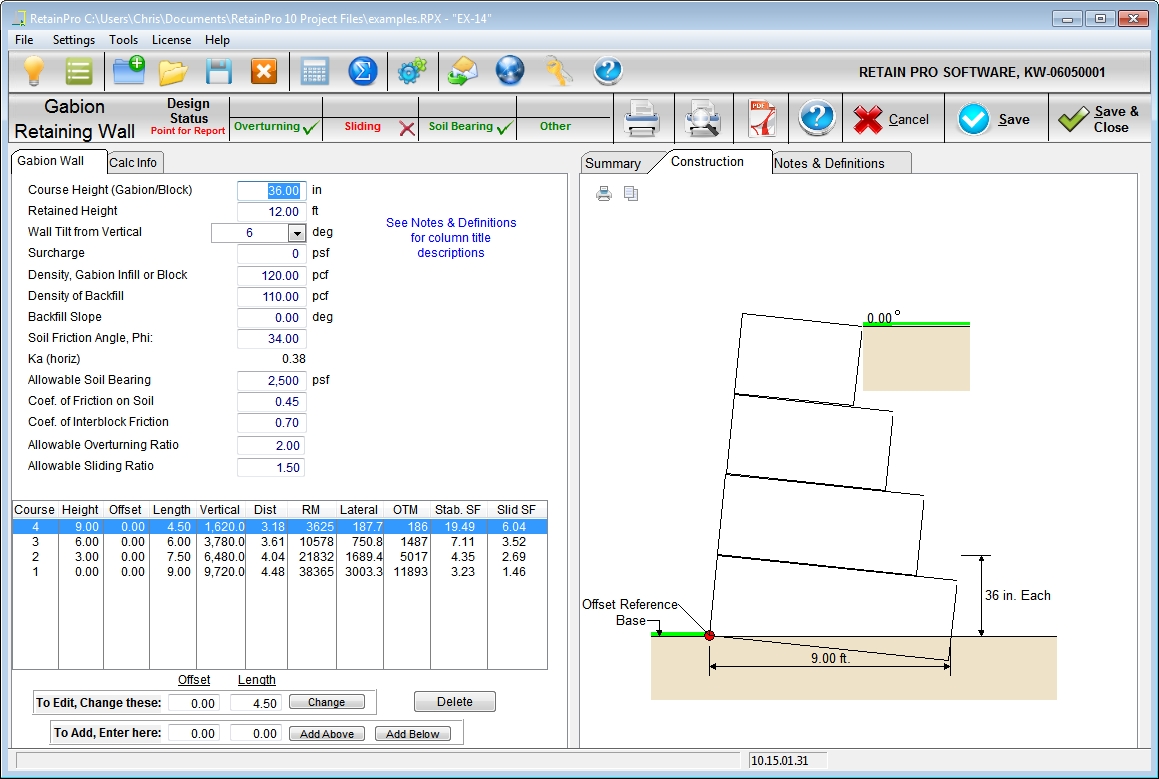Gabion Wall |

|

|
Gabion Wall
A gabion wall is a gravity wall constructed using prefabricated steel wire cages filled with rock. The cages are often 3 ft on a side and are infilled with stone as specified by the designer. In lieu of rock filled gabion cages, large precast concrete blocks may be used.
This program assumes all cages or blocks to be of uniform size and infill density. They can either be assembled vertically or tilted backward by selecting either 3° or 6° tilt. Maximum allowed height is 18 ft. A rule of thumb for the length of the bottom course is 75% of the retained height. The retained height is assumed to be the same height as the wall. The Coulomb equation is used for determining lateral earth pressure. As of July 2016 the Gabion Wall module uses the following values in the Coulomb equation: Angle of soil face of wall is equal to 90 degrees plus the user-specified wall tilt value, and the soil-wall friction angle is equal to (2/3) Phi.
This Gabion Wall program does not handle MSE (mechanically stabilized earth) walls, which use geogrids.

Notes:
1.All courses are of the same height and infill density.
2.If wall depth is uniform, consider using segmental retaining wall module with the gravity wall (no geogrids) option.
3.Concrete blocks may be used in lieu of gabion cages.
4.Offset of successive layers is limited to one-half course height. Earth side face flush.
5.Coulomb equation is used for active pressure. Wall friction angle is assumed zero.
6.If wall is battered, the effect can be modeled by introducing successive offsets (tan beta times course height).
7.This design is not valid for reinforced soils (Mechanically Stabilized Earth). Consider using Segmental Retaining Wall module instead.
8.Vendor specifications may apply.
| Course Height (Gabion/Block), In: | Height of the Gabion cages or block in inches. This is assumed uniform throughout. |
| Retained Height, ft: | Retained height in ft. which is also assumed to be the top of the wall. |
| Wall Tilt from Vertical, deg: | Select "None", 3°, or 6° backward tilt. |
| Surcharge, psf: | Surcharge load if applicable. |
| Density, Gabion Infill or Block, pcf: | Density of the infill or block. A rock infill is typically 120pcf and concrete block is typically 140pcf. |
| Density of Backfill, pcf: | Density of the backfill material, typically provided by the geotechnical engineer. |
| Backfill Slope, deg: | If applicable, enter the backfill slope in degrees. |
| Soil Friction Angle, Phi: | Obtain this from the geotechnical engineer. 35° is typical. |
| Ka (horiz): | Computed using the Coulomb equation with variables being phi, backfill slope and with wall/soil friction angle assumed to be 0°. |
| Allowable Soil Bearing, psf: | Obtain this value from the geotechnical engineer. |
| Coef. of Friction on Soil: | As determined by the geotechnical engineer. Typically 0.25-0.50. |
| Coef. of Interblock Friction: | Coefficient of friction to resist sliding between cages or blocks. A value 0.70 is often used. |
| Overturning Ratio: | Controlling ratio of the resisting moment divided by the overturning moment. |
| Sliding Ratio: | Computed for each level and is the ratio of the sliding resistance (weight of courses above times coefficient of interblock friction) and the applied lateral force. If it is less than 1.5 it will appear in red. |
| Act. Soil Bearing Pressure, psf: | Computed using conventional statics and appears in red if it exceeds the allowable cell bearing specified. |
Table of course entries and values
| Course: | These are numbered in ascending order and cannot exceed 10. |
| Height: | Measured from bottom of first (base) course. |
| Offset: | Measured from front edge bottom course. |
| Length: | Of cages or blocks in course. |
| Vertical: | Accumulated vertical load from courses above. |
| Dist: | Horizontal distance from front edge of bottom course to centroid of the referenced course. |
| RM: | Resisting moment at referenced course. |
| Lateral: | Accumulated lateral force from earth pressure and surcharge. |
| OTM: | Accumulated overturning moment above referenced course. |
| Stab S.F.: | RM / OTM |
| Sliding S.F.: | Vertical * (Coef. Interblock friction) / Lateral. |
Add, edit or delete courses using the buttons and input fields below the table. The first value entered will automatically be the bottom layer. To delete a course highlight it and click Delete.